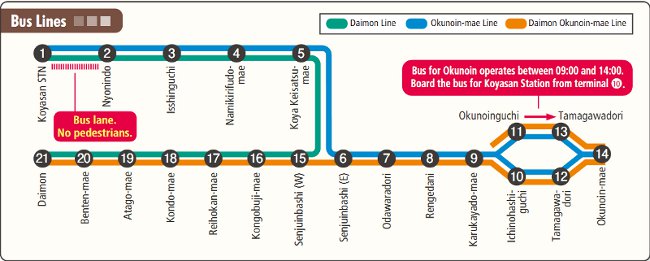 |
| HOME | FAQ |
MY TRIPS |
| OVERVIEW | MAPS | HISTORY | KŌYA-SAN |
KŌBŌ DAISHI |
HEART SUTRA |
PLANNING | PREPARATION | WALKING |
TEMPLE INFORMATION |
BOOKS, PAPERS, & VIDEOS |
OTHER INFORMATION |
|
Where To Stay These maps will tell you which bus stop to get off at to find your lodging. If your temple isn't listed, ask at the Kōyasan Train Station before getting on the bus to come into town. They'll tell you where to get off.
Choosing A Temple & Making Reservations: Everyone stays at one of the many, many temples found on Kōyasan. Reservations are made through this page of the official website of the Kōyasan Tourist Association. I used this service in 2011 and all communications were done in English. The system worked flawlessly and when i got to the temple they were obviously expecting us.
Lodging at the temples seems to have been standardized over the past few years and now everything goes through one reservation service. They have broken pricing down into four categories:
Where I've Stayed: I've stayed at four temples in the many times i've been there. I always used to stay at Haryo-in because they were the cheapest on the mountain, and probably stayed there three of four times in total. While Haryo-in is/was cheaper than anywhere else, it wasn't for the faint of heart. There is only one priest and he had medical issues sometime between my 1999 stay and my 2005 stay. He is barely understandable when you talk to him. A wonderful man with a heart of gold, but don't expect any chit chat. Heat seems to be non-existent inside the temple and it is near freezing in the mornings. The service in the morning is open to all, but very hard to see through the curtains and walls. The food is served in a dining room and is very good, but since i was the only one there, usually, i always ate alone. In 2011 and 2017 i stayed at Muryoko-in and that was like night and day. This temple is known for putting up foreigners and i've heard that several people there speak English. The food is OK, but sad to say, i don't think it was as good as at Haryo-in. You are served in your room so you won't get a chance to talk to any other guests. The morning service is open and quite an experience. No walls and no curtains. You'll enjoy it. After the service the head priest will chat with everyone. Then breakfast in your room again, followed by checking out. In 2015 i stayed at Shojoshin-in, very near the entrance to the cemetery leading to the Okunoin. It had good food and very friendly staff. During my last few trips there, i have stayed at Yochi-in and it has always been a very good experience. The rooms are nice, the food was reasonably good, but i don't think i'd call it special, and the morning service was interesting. None of the above are recommendations or endorsements. Just my experience. Youth Hostel: The maps of the area show that there is a Youth Hostel, but if you go to their website, a note in the Data section says that since 1/1/2011 they are "closed for the time being." I can only assume that this is still true, but am including this link because it lists a telephone and fax number. Kōyasan Youth Hostel Temple Food: Only vegetarian food is offered at the temples. Called shōjin ryōri in Japanese, it is delicious and i always look forward to meals when i'm there. Meals consist mainly of tofu and tofu-based dishes, miso soup, rice, and tea. Beer is available for purchase at every temple as far as i know. For more information on temple food: - Buddhist Cuisine (on Wikipedia) - Vegetarian Cooking (Shōjinryōri) and Tofu (on the official Kōyasan Tourist Association site)
Links:
|

